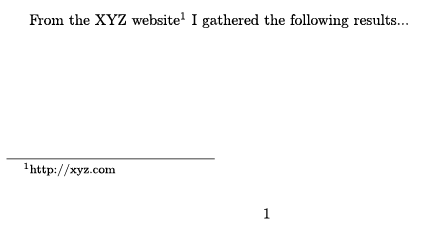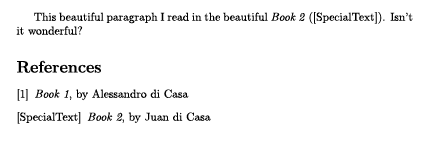Footnotes, References & Citations
Any scientific or documented piece requires footnotes, references, and citations. Luckily, LaTeX was mainly created for these purposes, which means it has very good support.
Footnotes
Footnotes are small superscript letters within the text, that refer to a small phrase at the bottom of the page (the note in the footer). They are used for comments, links or references to the material you used. To create one, use \footnote{text}. Footnotes are also counters, which means they are automatically numbered correctly.
1From the XYZ website\footnote{http://xyz.com} I gathered the following results...
Don’t use too many footnotes. If a paragraph is not important enough to be placed in your body text, consider if it should be in the document at all.
References
In reports and articles, references are often made to tables, figures, or other special segments. Again, LaTeX has you covered.
To label a certain segment, call \label{marker} somewhere in it, preferably near the top. You can make up your own marker names.
To place a reference to it somewhere else in the document, use \ref{marker}. If you want to display the page number that a certain marker is on, use \pageref{marker}.
1\section{Introduction}
2\label{sec:someMarker} Lorem ipsum...
3
4\section{Problem Statement}
5As seen in section \ref{sec:someMarker} on page \pageref{sec:someMarker}, ...
It’s customary to start your marker with an abbreviation of what it is you’re referring to. For example, sec:something refers to a section. It, again, helps with structure, hierarchy and semantics.
Bibliography
If you’re using or citing information from another source, your document requires a bibliography at the end. It’s simply a list of all the sources you’ve used.
A bibliography is created using the following thebibliography environment:
1\begin{thebibliography}{maxNum}
2 % ... items ...
3\end{thebibliography}The maxNum argument defines how large the bibliography will be, which is used by LaTeX to know how much space to reserve for in-document citations.
An item is added with \bibitem[label]{marker}, followed by the actual source. The optional label argument can be used if you don’t want the standard numbers to be used. Again, the marker you are allowed to make up yourself.
Within the document, use \cite{marker} to refer to the bibliography item.
1This beautiful paragraph I read in the beautiful \textit{Book 2} (\cite{marker2}). Isn't it wonderful?
2
3\begin{thebibliography}{2}
4 \bibitem{marker1} \textit{Book 1}, by Alessandro di Casa
5 \bibitem[SpecialText]{marker2} \textit{Book 2}, by Juan di Casa
6\end{thebibliography}
Want to support me?
Buy one of my projects. You get something nice, I get something nice.
Donate through a popular platform using the link below.
Simply giving feedback or spreading the word is also worth a lot.